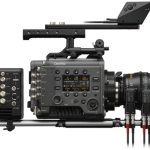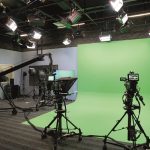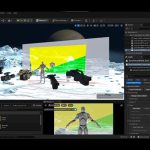The small and compact Sony Burano packs a punch with its myriad features, including an auto-focus function that makes it well-suited for solo shoots, says Dubai-based DoP Timothy Fare-Matthews.
The Sony Burano is the newest kid on the block in the Sony Cineline family. It might be Sony’s most significant move since the introduction of the FX6, which really revolutionised how I worked and managed to execute a lot with a little.
What do I mean by a little, exactly? Well, our team members wear many hats on a production. We rarely have a first or second AC on set. We use the auto functions, we like having as little kit with us as possible, and the nimble, lean approach enables us to react quickly to the unpredictability of the production industry.
The Burano hits the market this month, and I won’t be surprised if it becomes one of the most popular cameras by the end of 2024 owing to its solo shooting benefits. Before I dive into its features, it’s important to understand why the Burano was destined for launch now, and why I feel it will dominate the premium production market moving forward.
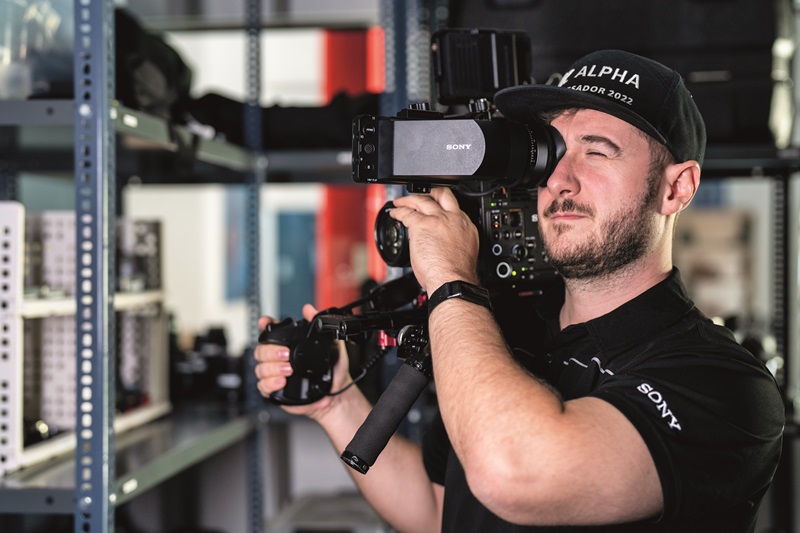 In recent years, Sony has made impressive strides in the feature market, evident in its top placement in the Cinematography Nominees Camera Manufacturers Chart at the Emmys. Why is this important? Well, it demonstrates that Sony is now executing at the level where the top people in the industry play, yet it still caters to something a student would use, like a small ZVE-10. The company has invested heavily in cascading technology and content-capturing capabilities, from its flagship models to more affordable equipment, making this ecosystem highly relevant.
In recent years, Sony has made impressive strides in the feature market, evident in its top placement in the Cinematography Nominees Camera Manufacturers Chart at the Emmys. Why is this important? Well, it demonstrates that Sony is now executing at the level where the top people in the industry play, yet it still caters to something a student would use, like a small ZVE-10. The company has invested heavily in cascading technology and content-capturing capabilities, from its flagship models to more affordable equipment, making this ecosystem highly relevant.
But the gap has always been quite large. I always used to struggle as a DOP going from something like an FX6 or FX9 to a Venice, because the latter, like any equivalent camera, requires an entire infrastructure to operate.
The Burano completes the Cineline puzzle, bridging the gap from Alpha/low-end Cineline users (where all the handy ergonomics exist) to the flagship cinema-level Venice 2. It’s as if the Venice 2 and the FX6 had a child, capable of outperforming each in certain aspects.
Out of the box, it feels incredibly well-built. It looks and feels like a baby Venice. If you are an FX6 user, you will instantly recognise many similarities with the button layout and noticeable features on the smart side of the body. It has a pretty decent future-proof 8.6K full-frame sensor. Though not identical to the Venice 2 sensor, it’s designed for ergonomic use with auto features, which we’ll explore shortly.
However, you will experience some drawbacks in the resolution area. When I get my hands on any new camera, I first head straight to the recording formats and frame rates menu to see what I have to play with. The Burano supports full-frame 8.6K at 30 fps, full-frame cropped (only slightly) at 6K at 60 fps, Super35 5.8K and Super35 cropped 4K at 120 fps. Depending on future firmware updates, my guess is you wouldn’t rush out to get this for its frame rates, but if you’re not too concerned about the high speed then it certainly makes up for it in other areas.
I used the Burano for a recent production, shooting in low light at La Perle, Habtoor City in Dubai, and despite the challenge low-frame rate options Super35 mode gave me, I still got a very stunning image with very little noise visible. Anyone who has attended the theatrical productions at La Perle will be familiar with how dark and challenging that environment is to capture. What the camera lacked in terms of frame rate and resolution options, it made up for with its incredible ergonomic features and detail.
The lighting at the event varied tremendously, so the fact that the Burano offers 16 true stops of latitude really helped us play with and expose the footage correctly later in the edit. What helped us again in terms of ergonomic features was the 16-bit XOCN codec (Sony’s RAW). I have worked with XOCN-XT from the Venice before and was familiar with how well that performs, so I was expecting a drop, as this only delivers an XOCN-LT codec (the Venice does XOCN-ST and XT). For what I was producing and for the Dubai market we rarely feel the need for XT, so the fact that this gave me an incredibly sharp, well-captured, clean-looking image was impressive.
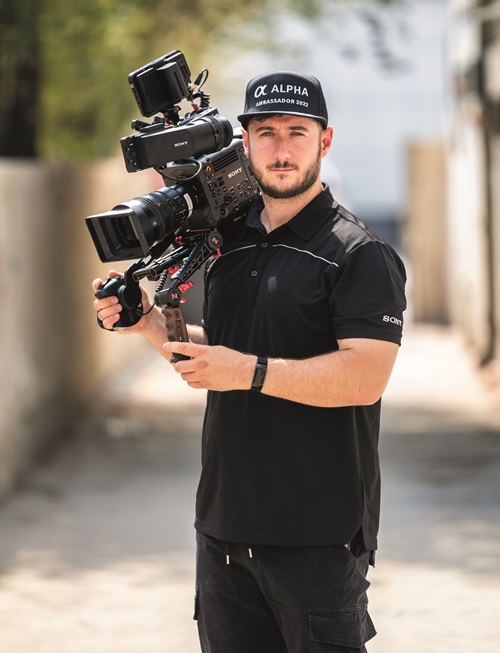
It uses CF-Express Type B cards, commonly used by other cameras and brands in the market, thereby making it a more affordable memory solution compared to the Venice AXS cards. How much information you get with LT can be clearly found on the charts at sonycine.com. At 4K XOCN XT (24p) you get 965MBPS, compared to 389MBPS at LT, slightly surpassing the XAVC Class480 Codec familiar from the Sony PMW-F55 while retaining the flexibility of Sony’s RAW (XOCN codec).
Like its siblings the FX6 and FX9, the Burano features an impressive internal variable ND. If you have never used one, you will find it very difficult to go back to a life without it. To have a variable ND on a camera with a sensor of this size is very impressive. It goes from ND 1/4 all the way up to 1/128, comparable to 2 to 7 stops difference.
One really useful feature is the IBIS (In-Built Image Stabilisation). I used this with the Sony G Master glass, so naturally I would expect it to perform very well. The FX6, FX9 and Venice do not have this feature, which again makes the Burano a camera of its own class.
But the question is: does the industry require this? It has its pros and cons. On the one hand, it provides solo shooters with a more practical, easier way to shoot handheld content. On the flip side, having a sensor capable of IBIS means it isn’t locked, which restricts the ability to rig or get stable footage if it is mounted on something with intense vibrations (for example, a race car). But if people are doing lots of challenging shots like that and working on incredibly high-end projects, they have the Venice 2 and the Rialto to go to.
One standard the Cineline offers, which I am happy also exists in the Burano, is its dual base ISO of 800/3200, essential for two native clean sensitivity modes, ideal for low-light shooting. The La Perle shoot was incredibly dark, so I pretty much had the camera on 3200 the entire time. Rarely did I need to add extra gain to the image. This is why I think the Super35 Scan mode behaved so well, as the image is incredibly clean.
This camera accomplishes tasks faster at arguably better quality with fewer crew
The Burano’s main selling point for me is its auto functions. It’s like having a Venice that can auto-focus. Despite scepticism about using auto in feature-level or commercial work, I urge you to try it. It would have been impossible for me to capture that look and feel at La Perle on my own without this technology. But to fully maximise its potential, you need to use lenses catering to AF and E mount. The Burano comes with a standard PL mount which easily comes off with a few screws, and what lies beneath is a locking Sony E mount with autofocus capabilities, simplifying operations for solo shooters like those who would use an FX6.
One oversight on Sony’s part is that the PL metadata sensors are exposed once the mount is off. An easy fix is to put some tape across it to ensure protection while you’re out and about shooting. The E-mount and AF functions open up a vast array of possibilities that would typically require monitors, cables, FIZ units and a first AC. I recently filmed a walking piece-to-camera with the Burano using a 50mm 1.2 on an Easyrig, nailing the take in one shot without focus issues.
The viewfinder, with its touch-tracking function, also significantly eases camera operation. In a scenario like at La Perle where you have someone flying around the room, you’re able to easily track them correctly by keeping them in the frame. You can simply touch the viewfinder screen on the subject you want to focus on. Keep the lens on AF, and the camera does the rest. It also has modes in order to speed or slow down the feel and pull of the focus.
The Burano’s main selling point for me is its auto functions. It’s like having a Venice that can auto-focus.
As content consumption increasingly shifts to mobile phones and technology simplifies shooting, the question is whether we still purchase cameras solely based on quality, even for top-tier Netflix-style productions. I would argue, no. Jamie Lin, an early adopter of the Burano, believes each camera serves its purpose: “The Burano is perfect for high-resolution projects where mobility and time are of the essence. It may not replace a Venice 2 on a feature film set, but for documentaries, music videos and commercials, it’s unmatched.”
This camera accomplishes tasks faster at arguably better quality with fewer crew members, freeing up budget for other production elements. We’ve all experienced delays waiting for crew to change a filter or adjust focus. Those days are over with the Burano. In conclusion, the Sony Burano emerges as a versatile powerhouse, seamlessly blending high-resolution capabilities with intuitive auto functions, streamlining production workflows and setting a new standard for efficiency and quality across diverse projects.
Timothy Fare-Matthews is a DoP and co-owner of First and Ten Productions in Dubai.








































































